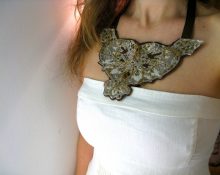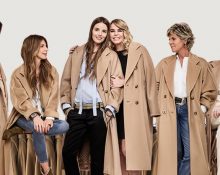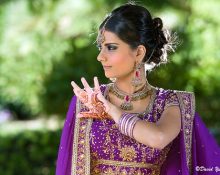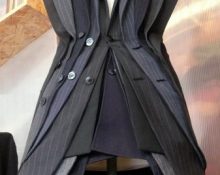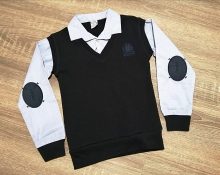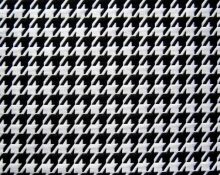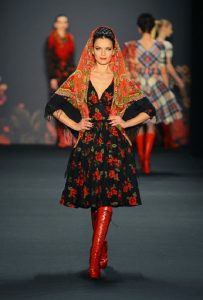
creativecommons.org
The “a la rus” style is one of the most complex and capricious styles that has reached the 21st century. On the one hand, clothes in this style regularly appear at fashion shows and red carpets, and on the other hand, due to their initial artificiality and masquerade, it is difficult for the average person to find a reason to wear an outfit in this style. This is the materiale we will talk about the history of the style and its formation, and also give examples of what you can wear with items in the “a la Russe” style and how to choose the right wardrobe in the pseudo-Russian style.
Brief definition of the style “a la rus”
Style “a la rus” is a style, imitating Russian folk (and diverse) architecture/clothing. The key word here is “imitative”, since the “a la Russe” style is not equivalent to folk art, it is a more refined version with more careful finishing and more expensive materials. It is understood that in the style “a la rus” there is a certain amount of theatricality.Most often, this style can be seen at fashion shows, red carpets and historical film adaptations.
History of the formation of the style “a la rus”
It is ironic that the period of formation of the “a la Russe” style occurred precisely at the beginning of the 19th century, when Napoleon’s troops entered the territory of Russia and, according to all the laws of logic, representatives of all classes in the Russian Empire had no time for fashion. It is doubly ironic that literally the entire Russian elite of that time spoke only French, studied from French textbooks and dressed according to fashionable Parisian magazines. This idea of the categorical superiority of everything foreign over everything domestic was instilled by Peter I, who forcibly introduced the fashion for the Dutch camisole, and it, having taken hold, has survived to this day. But in 1812 there was a turning point in consciousness: and it was not only that the aristocracy wore European clothes, that year ordinary peasants who fought a guerrilla war played a very important role. Despite the fact that after the end of the war their living conditions did not change, society on a subconscious level noted (albeit in a rather peculiar way) that the authority of the people had risen to a new level. So, Russian nobles organized balls in the “a la Russe” style, dressing up in exquisite clothes vaguely reminiscent of sundresses, kosovorotkas, soul warmers and kokoshniks. The next unexpected turn of fashion for the new style “a la Russe” was the victory of Russia in the war with Napoleon. When the Cossacks entered Paris, in addition to the Russian word “quickly,” the French also adopted a way of dressing: Parisian fashionistas put on wide trousers, reminiscent of Cossack hats, fluffy hats, as well as outerwear with fur trim.Formally, it was this moment that became the moment of the birth of the “a la russe” style. But after the surge of Russophilia, there was a lull again, which lasted until the beginning of the twentieth century.
Many fashion designers begin counting the history of the “a la russe” style precisely in 1908, when the first of many ballets brought to Europe by Sergei Diaghilev premiered in Paris. That year, Diaghilev’s “Russian Seasons” went down in history, and the organizer himself began to be called nothing less than “the great impresario.” To be honest, the idea of reviving the style was in the air and was even approved “from above.” The fact is that in 1903 a costume ball, remembered by many, took place, at which the entire royal family and their entourage dressed in boyar clothes. This was how the trend towards Russianness was set. Therefore, when a few years later Diaghilev announced his big project, he was supported and financed. In 1907, the costumes invented by the best artists were inspired by the history of Russian folk costume and its originality. This is how outfits appeared for the ballet performances “The Firebird”, “The Rite of Spring”, “The Tale of the Buffoon”, “Petrushka”, “Sadko” and many other works based on Russian history or folklore. On the one hand, these were adaptede for the dancers, Russian folk costumes, and on the other hand, a significant part of the decorative elements were taken from other nations and organically woven into the overall image of the character. Such famous artists as Nicholas Roerich, Natalya Goncharova, Mikhail Larionov and the legendary Lev Bakst worked on ballet costumes (both from a visual and aesthetic point of view, and from a practical point of view).Parisian artists did not remain aloof from the process: Coco Chanel herself sewed the costumes for Maya Plisetskaya, avant-garde artist Sonia Delaunay was responsible for the graphic costumes of Cleopatra and her retinue, and the one-act ballet “Parade” was designed from start to finish by Pablo Picasso. These events could not but affect fashion.
Clothes in the “a la Russe” style
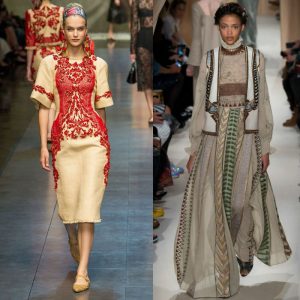
creativecommons.org
The “a la Russe” style appeared on Russian streets thanks to fashion designer and trendsetter Paul Poiret. He liked that, despite its original severity and geometricity, the “a la russe” style also retains elegance and sophistication. Russian style successfully overlapped with the Art Deco era, becoming a logical continuation of the fashion trend. The year after the release of the ballets, Poiret created a series of outfits inspired by “Diaghilev’s ballets” and bright folk motifs: wide styles, furs and bright prints became part of fashion history. Additionally, the effect was consolidated by the tragic events of 1917, when after the revolution a significant part of the nobles, the flower of the nation, left the former Russian Empire. Impoverished and bloodless, they were still people with good education and good taste. Russian tea houses with samovars and stuffed bears, as well as restaurants where, instead of singers, the public was entertained by gypsies, became popular. Less fortunate compatriots got hired to work: for example, Coco Chanel hired more than 20 Russian emigrants who sewed, embroidered and worked as models, and many Parisians bought lace and embroidery from Russian craftswomen on principle in order to observe all the decencies of fashion and support people in difficult situations . Fashion houses like Chanel and Lanvin have been working on collections in the “a la Russe” style for several seasons.Moreover, people of blue blood, princesses and representatives of the House of Romanov came out to show off these outfits. During the same period, fashion houses founded by wealthy migrants began to rise to the occasion: the iconic IrFe, created by Irina and Felix Yusupov, as well as through sleepless nights spent embroidering Kitmir, opened by Grand Duchess Maria Pavlovna.
The third wave of love for the “a la russe” style was provoked by the collection of Opera-Ballets russes by Yves Saint Laurent, who headed the Christian Dior fashion house and had already visited closed Russia. Yves Saint Laurent was also impressed by the ballet, but this time it was not Diaghilev’s Russian Seasons.
What wardrobe elements in the “a la russe” style are popular today?
Until now, the “a la Russe” style, like any ethnic style, remains quite selective. Firstly, it is impossible to create your entire wardrobe from one a la Russe. But you can intelligently introduce several everyday images. The main role should be played by ornament and material: rhythmic patterns, contrasting colors, natural fur trim, lace sleeves. The modern interpretation of the “a la Russe” style is not so bright: few ordinary people often attend historical reconstructions or theme parties, and you won’t wear a caftan to the office for a long time. Moreover, new trends have also made their contribution. The fashion for environmentally friendly products has done its job and more and more women began to abandon fur coats and decor made from natural fur. But this does not mean that the “a la Russe” style ceased to exist. Today there is a series of so-called modern kokoshniks, which serve as headbands, embroidered trousers, as well as dresses with elements of ancient Russian ornaments.Natural fur is increasingly being replaced with artificial fur, tall hats are coming back into fashion, knitted stoles are popular not only among the older generation, and in winter preference is given to cozy analogues of felt boots - uggs. Any elongated sheepskin coat, with a small patch and flare, can become a worthy element in the “a la Russe” style. The level of elegance of the “a la russe” style can be adjusted by the materials: velvet and satin items with embroidery are more suitable for evening events, but pastel-colored items made of cotton and linen can be worn every day. And for theme parties, you can decide to wear kitsch: a Khokhloma-inspired tracksuit or a T-shirt with a popular print from Denis Simachev, a bright shirt with “cucumbers” from Slava Zaitsev.


 0
0